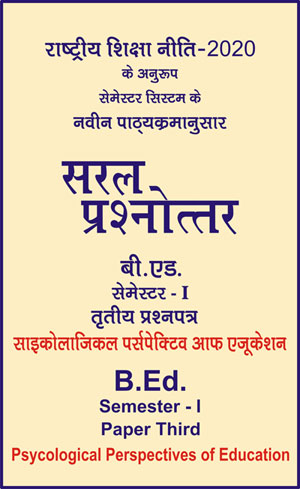|
बी एड - एम एड >> बी.एड. सेमेस्टर-1 प्रश्नपत्र-III - साइकोलाजिकल पर्सपेक्टिव आफ एजूकेशन बी.एड. सेमेस्टर-1 प्रश्नपत्र-III - साइकोलाजिकल पर्सपेक्टिव आफ एजूकेशनसरल प्रश्नोत्तर समूह
|
5 पाठक हैं |
|||||||
बी.एड. सेमेस्टर-1 प्रश्नपत्र-III - साइकोलाजिकल पर्सपेक्टिव आफ एजूकेशन (अंग्रेजी भाषा में)
Thorndike’s Error and Trial Theory
-
Which of the following was a major implication of Thorndike’s Puzzle Box?
(a) S-R Theory is entirely wrong
(b) Pavlov was incorrect about classical conditioning
(c) Trial and error informs the relationship between stimulus and response
(d) Animals learn only through contiguity -
Thorndike put a hungry .......... in a puzzle box for his experiment.
(a) Dog
(b) Rat
(c) Cat
(d) None of the above -
Which of the following methods of verbal learning is used to find out how participants learn the lists of verbal items?
(a) Paired association learning
(b) Serial learning
(c) Free recall
(d) None of the above -
.......... occurs most readily for strong responses in situations where the presence of others is motivating.
(a) Social relationship
(b) Social facilitation
(c) Socialization
(d) None of the above -
.........., a cluster of interrelated traits and attributes assumed to be characteristic of certain kinds of individual.
(a) Prejudices
(b) Stereotype
(c) Attribution
(d) None of the above -
.......... and his colleagues in a series of experimental studies investigated observational learning in detail.
(a) Skinner
(b) Bandura
(c) Tolman
(d) Hull -
Which of the following laws of learning on the basis of his propounded by Thorndike theory?
(a) The law of readiness
(b) The law of effect
(c) The law of exercise
(d) All of the above -
Which of the following is an important schedule of reinforcement?
(a) Continuous
(b) Fixed interval
(c) Fixed ratio
(d) All of the above -
.......... technique is based on the interaction between classical and instrumental conditioning.
(a) Assertiveness learning
(b) Systematic desensitisation
(c) Biofeed-back treatment
(d) None of the above -
Which of the following theories is like a set of correlations that enable us to go beyond the information given about a person and to fill in the missing data?
(a) A miniature theory of personality
(b) An implicit personality theory
(c) Attribution
(d) None of the above -
.......... are cognitions, or thoughts, about the characteristics of objects.
(a) Attitudes
(b) Beliefs
(c) Prejudice
(d) Perceptions -
Systematic desensitization is used :
(a) To eliminate habits that are undesirable
(b) To help those suffering from excessive anxieties
(c) To modify maladaptive behaviour
(d) To increase attendance -
When something previously learned benefits, performance or learning in a new situation is said to be :
(a) Positive transfer of learning
(b) Negative transfer of learning
(c) Zero transfer of learning
(d) None of the above -
Which of the following factors influenced the learning?
(a) Motivational variables
(b) Fatigue
(c) Knowledge of result and feedback
(d) All of the above -
.......... the father of behaviorism supported Pavlov’s ideas on conditioned responses.
(a) Hull
(b) Johan Watson
(c) Tolman
(d) Skinner -
.......... learning is different from conditioning and is limited to human beings.
(a) Concept
(b) Latent
(c) Verbal
(d) Instrumental -
Learning disability refers to a heterogeneous group of disorders manifested by difficulty in the acquisition of learning :
(a) Reading
(b) Speaking
(c) Writing
(d) All of the above -
The behaviour of children can easily be modified and shaped through the use of the :
(a) Classical conditioning
(b) Operant conditioning
(c) Verbal learning
(d) Concept learning -
The measures the electrical resistance of the skin :
(a) EMG
(b) GSR
(c) EEG
(d) ECG -
In the study of verbal learning, psychologists use a variety of materials including :
(a) Nonsense syllables
(b) Familiar words
(c) Unfamiliar words
(d) All of the above -
The most recent, and most promising, physiological measure involves .......... recording from the major facial muscles.
(a) Electromyographic (EMG)
(b) Electroencephalogram (EEG)
(c) Galvanic Skin response (GSR)
(d) None of the above -
The first major attempt to formulate implicit rules was made by :
(a) Bern
(b) Fritz Heider
(c) Festinger
(d) Carl Smith -
.........., like most other attitude-measurement techniques, relies on the self-report of the respondents.
(a) Physiological measures
(b) Public opinion polling
(c) Interview
(d) Case study -
The distinguishing feature of the approach is its emphasis on the individual's “Phenomenology”.
(a) Developmental
(b) Social-Psychological
(c) Physiological
(d) Cultural -
Which of the following therapies is used in the case of those children and adults who exhibit irrational and unfounded fear with accompanying avoidance behaviour?
(a) Implosive therapy and flooding
(b) Aversion therapy
(c) Modeling
(d) Biofeed-back treatment - Noted in his famous book on prejudice that interracial contacts lead to decreased prejudice only when the participants are of equal status :
(a) Fritz Heider
(b) Gordon Allport
(c) Carl Smith
(d) None of the above
|
|||||














